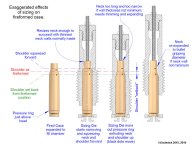Cdoc42,
Yes. Graphite coating to improve flow, repel water, and conduct static electricity (the reason black powder has long been glazed with it) is what makes most smokeless powders look black. If you look at powder that extinguished early in a failed ignition, it looks a little like sticks or spheres of bee's wax fused together. That's because the outer layer, including the graphite, burned off before it extinguished. (There's an explanation of why smokeless powder can extinguish, despite supplying its own oxygen, in the 2013 print version of the Norma databook, for anyone interested.)
Burbank Jung,
Always glad to help sort out confusion.
The unique advantage of the Lee Collet neck sizing die is that it sizes to a specific inside diameter determined by its mandrel, and not to a specific outside diameter determined by a die profile or bushing do. This means the Lee die always sizes the right amount (assuming you apply enough pressure) regardless of how thick the brass in the cartridge neck is. The standard die style relies on over-resizing necks and then expanding the ID to correct diameter in order to work universally with all different neck wall thicknesses. A bushing die lets you select a bushing to bring the neck to an OD that results in a desired ID, but that usually means having two or more bushings to allow that different makes or sometimes just different lots of brass may have different neck wall thicknesses. Also, where the mandrel on the LEE will open up small case mouth dents as the case enters the die, you need at least a next-caliber-smaller expander in a standard or bushing sizing die to expand neck dents.
Keep in mind the Lee Collet Die only resizes the case neck, same as a neck-sizing-only bushing die does. To get some shoulder setback you use another die. This can be a Redding Body Die, which is inexpensive and made for this sort of thing, or a Bushing Full Length sizing die without the bushing in place. You can also use the Forster Bushing-Bump Die with no bushing if you only want to shorten the head-to-shoulder length, but not narrow the case diameter (less brass working and less trimming needed, but the possibility, as with neck sizing only, that the die will eventually need to go through an FL die to keep fitting into the chamber. Whether or not that happens depends on how much peak pressure you are loading the brass to and how thick your chamber walls are. Some mild loads in some rifles never stretch to brass diameter hard enough not to spring back to fit again and never need FL resizing. Others need it in just two or three load cycles.
I always use the Redding Body Die with the Lee Collet die for cartridges to be fed from a magazine. In the military-style floating firing pin self-loaders there is added potential for slamfires or out-of-battery firing if the cases don't feed with minimal resistance, so I don't trust a snug diameter with these.
Bushing dies, whether FL or Bushing Bump can also be used with a bushing rather than using the Lee Collet Die at all. The main advantage to the Lee die, in addition to the controlling the neck ID being produced is the intrinsic straightness of the resized case (see
this video.
Decisions, decisions.
Graphite and
Motor Mica are both common dry neck lubes. NECO sells a system that uses acid-neutralized molybdenum disulfide powder, though be cautioned that a little of that will get into the bore, which can affect your velocity and sweet spot, making you tweak the load when it settles. The same applies to hex-from boron nitride (hBN). But the added lubrication has the value of tending to reduce metal fouling in the bore. Indeed, G. David Tubb sells his TubbDust that you mix with powder precisely for the reduction of metal fouling.
All the above are generally employed on the premise a wet lube or a wax can affect powder ignition and burning rate. In handgun loading, for which wax and grease-lubricated bullets have been a longtime mainstay, you very occasionally hear of someone who had a squib load they blame on their powder being wetted by bullet lube, perhaps when the cartridge got too hot someplace, melting the wax. But that's pretty unusual. Also, because one kind of powder breakdown occurs that makes the powder look oily, you can also be looking at a case of mistaken identification of the real problem in those instances. Wax lubricated bullets (.22 Rimfire and others) have been around without causing a problem for a long time. So my sense is the effect is an overblown worry for the most part. Could you detect the difference in a high precision benchrest load? Maybe. The simplest test would be to dry lube a bunch of necks and wet lube a bunch and see which one produces the lower velocity SD. Make enough for a few tests and reshoot the test periodically as the ammunition ages to make sure nothing has changed.

